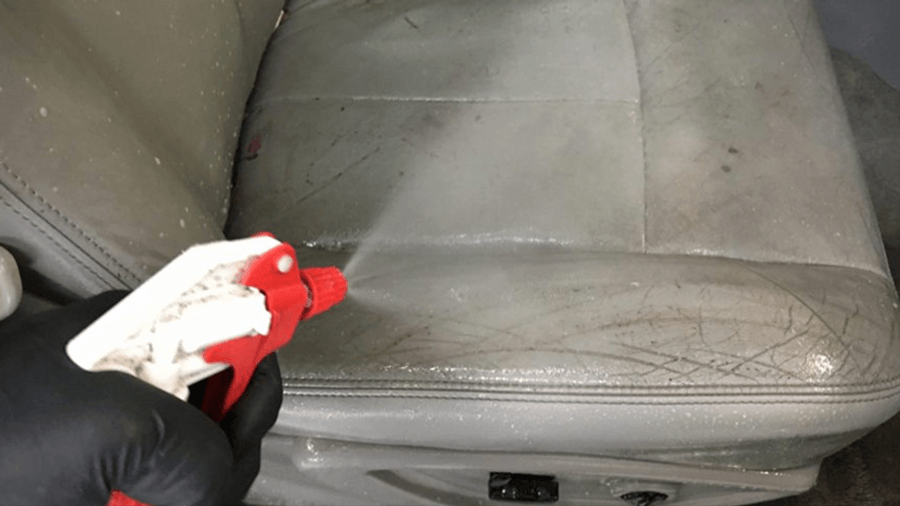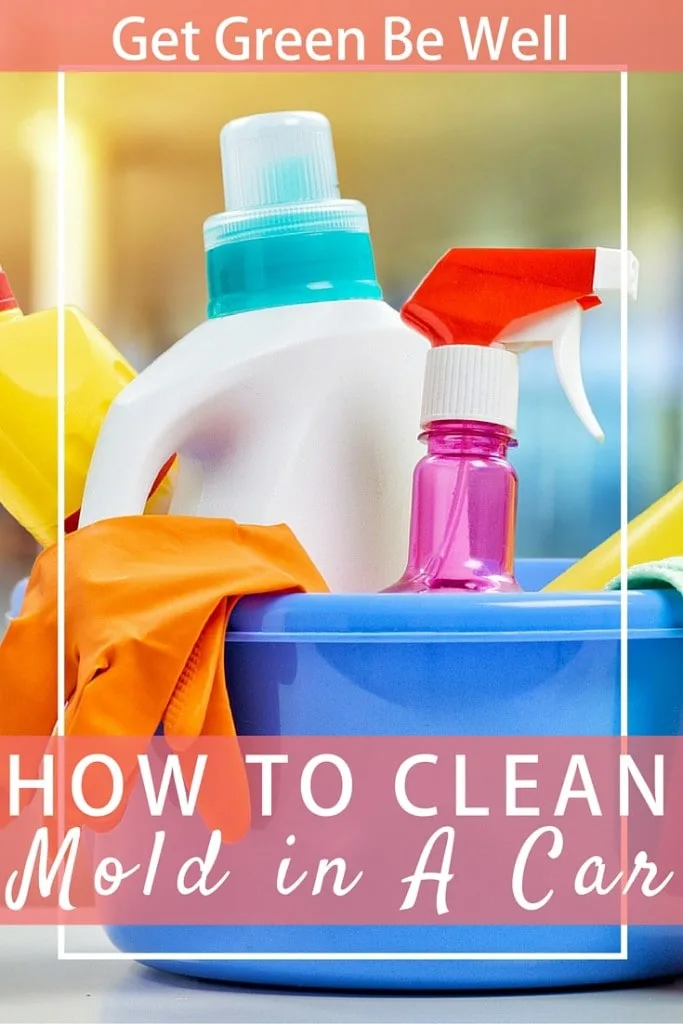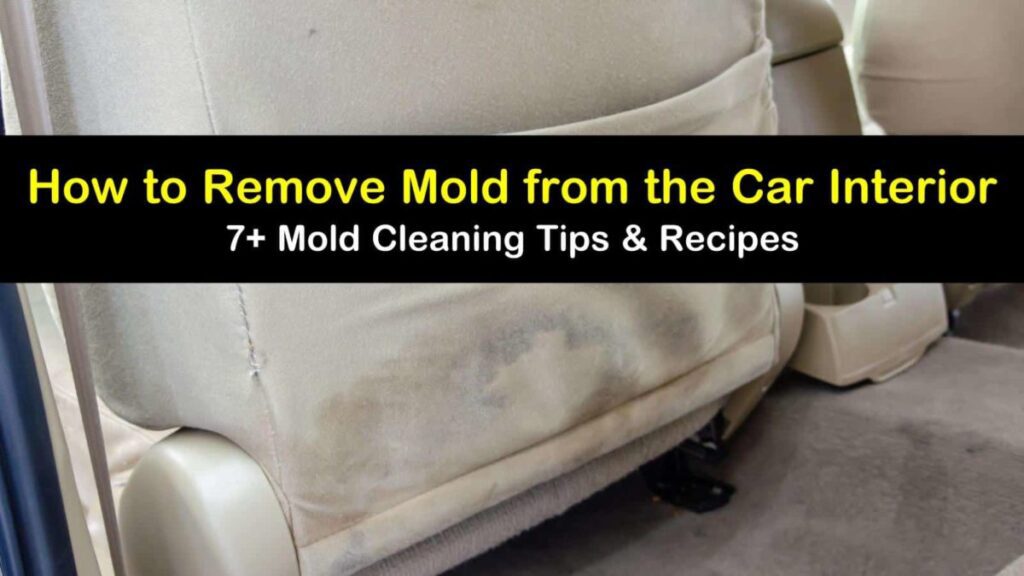If you’ve ever experienced the unpleasant presence of mold in your car, you’ll know how frustrating and smelly it can be. But fear not, because there may be natural or do-it-yourself options available to help you tackle this problem. This article explores whether there are any effective methods for removing mold from the interior of your car, without the need for harsh chemicals or expensive professional services. Discover some handy tips and tricks that could save you time, money, and the hassle of dealing with car mold.

Preventing Mold Growth
Proper ventilation
Proper ventilation is crucial in preventing mold growth in your car. Make sure to keep your car windows open or cracked whenever possible, especially during humid or rainy weather. This allows air to circulate and helps to prevent the buildup of moisture. Additionally, using the air conditioning or heating system in your car can help to maintain optimal moisture levels and prevent mold growth.
Keep car clean and dry
Keeping your car clean and dry is another important step in preventing mold growth. Regularly cleaning and vacuuming the interior of your car will help to remove any dirt, dust, or potential food sources for mold. It’s also essential to dry any moisture or spills as soon as possible to prevent them from seeping into the upholstery or carpeting where mold can thrive.
Remove wet or damp items
If you accidentally leave wet or damp items in your car, such as wet clothing or towels, it’s important to remove them promptly. Wet items provide an ideal environment for mold to grow, and if left unchecked, the mold can spread to other parts of your car. Take the time to dry out any wet items thoroughly before placing them back in your car to ensure that mold growth is minimized.
Use a dehumidifier
Using a dehumidifier in your car can be an effective way to reduce excess moisture and prevent mold growth. Dehumidifiers work by removing moisture from the air, helping to maintain a drier environment in your car. Simply place the dehumidifier in your car and let it run for a period of time to remove any excess moisture. This can be particularly helpful in areas with high humidity levels or during the rainy season.
By implementing these preventative measures, you can significantly reduce the likelihood of mold growth in your car and maintain a clean and healthy environment.
Identifying Mold in Car Interior
Visible signs of mold
One of the most obvious ways to identify mold in your car interior is through visible signs. Mold often appears as black or green spots or patches on surfaces such as seats, carpeting, or dashboard. Keep an eye out for any discoloration or unusual growth on these surfaces, as it may indicate the presence of mold.
Musty odor
Another indication of mold in your car is a persistent musty odor. Mold has a distinct smell that is often described as musty or earthy. If you notice an unpleasant odor that lingers in your car, even after cleaning, it could be a sign that there is mold hidden somewhere within the interior.
Allergic reactions
If you experience allergic reactions such as sneezing, coughing, or itchy eyes whenever you’re in your car, it could be a result of mold exposure. Mold spores can trigger allergic reactions in sensitive individuals, so pay attention to any symptoms you may be experiencing and consider the possibility of mold contamination.
It’s important to be vigilant and proactive in identifying mold in your car interior to address the issue promptly and prevent further growth and potential health hazards.
Natural Options for Removing Mold
Vinegar solution
Vinegar is a natural and effective option for removing mold from various surfaces in your car. To create a vinegar solution, mix equal parts white vinegar and water in a spray bottle. Spray the solution onto the affected areas and let it sit for a few hours. Then, scrub the area with a brush or cloth to remove the mold. Finally, wipe down the area with a clean cloth and allow it to dry completely.
Tea tree oil
Tea tree oil is a powerful antifungal and antibacterial agent that can help eliminate mold from your car interior. Mix two teaspoons of tea tree oil with two cups of water in a spray bottle. Spray the mixture onto the moldy areas and let it sit for a few hours. Then, scrub the area with a brush or cloth to remove the mold. Finally, wipe down the area with a clean cloth and allow it to dry thoroughly.
Baking soda
Baking soda is another natural option for removing mold from your car interior. Create a paste by combining baking soda with water and apply it to the moldy areas. Allow the paste to sit for several hours before scrubbing it off with a brush or cloth. Rinse the area with clean water and dry it thoroughly.
Grapefruit seed extract
Grapefruit seed extract is known for its antimicrobial properties, making it an effective natural option for removing mold. Mix 10 drops of grapefruit seed extract with two cups of water in a spray bottle. Spray the solution onto the moldy areas and let it sit for a few hours. Then, scrub the area with a brush or cloth and wipe it down with a clean cloth. Allow the area to dry completely.
Hydrogen peroxide
Hydrogen peroxide is a powerful oxidizing agent that can help kill mold spores. Mix equal parts hydrogen peroxide and water in a spray bottle. Spray the solution onto the moldy areas and let it sit for 10 minutes. Then, scrub the area with a brush or cloth and wipe it down with a clean cloth. Make sure to rinse the area thoroughly with water and dry it completely.
These natural options provide effective alternatives to harsh chemicals for removing mold from your car interior while minimizing potential harm to you and the environment.
DIY Solutions for Mold Removal
White vinegar spray
Create a white vinegar spray by combining equal parts white vinegar and water in a spray bottle. Spray the solution onto the moldy areas and let it sit for a few hours. Then, scrub the area with a brush or cloth to remove the mold. Finally, wipe down the area with a clean cloth and allow it to dry completely.
Tea tree oil spray
Mix two teaspoons of tea tree oil with two cups of water in a spray bottle. Spray the mixture onto the moldy areas and let it sit for a few hours. Then, scrub the area with a brush or cloth to remove the mold. Finally, wipe down the area with a clean cloth and allow it to dry thoroughly.
Baking soda paste
Create a paste by combining baking soda with water and apply it to the moldy areas. Allow the paste to sit for several hours before scrubbing it off with a brush or cloth. Rinse the area with clean water and dry it thoroughly.
Grapefruit seed extract solution
Mix 10 drops of grapefruit seed extract with two cups of water in a spray bottle. Spray the solution onto the moldy areas and let it sit for a few hours. Then, scrub the area with a brush or cloth and wipe it down with a clean cloth. Allow the area to dry completely.
These DIY solutions offer accessible and effective methods for removing mold from your car interior without the need for expensive or harsh chemical products.

Removing Mold from Fabric Seats
Vacuuming
Start by vacuuming the fabric seats to remove any loose mold spores and debris. Use a brush attachment to loosen the mold from the fabric, making it easier to remove.
Applying natural solutions
Choose one of the natural solutions mentioned earlier, such as vinegar solution or tea tree oil spray. Spray the solution onto the moldy areas of the fabric seats and let it sit for a few hours. Then, scrub the area with a soft-bristle brush to remove the mold. Wipe the seats with a clean cloth to remove any excess moisture and allow them to air dry completely.
Steam cleaning
If the mold is deeply embedded in the fabric seats, steam cleaning can be an effective method for removal. Rent or purchase a steam cleaner designed for upholstery and follow the manufacturer’s instructions. This process will not only remove mold but also sanitize the fabric seats, leaving them fresh and clean.
Removing Mold from Leather Seats
Wipe with vinegar solution
Create a vinegar solution by mixing equal parts white vinegar and water. Dampen a clean cloth with the solution and gently wipe down the leather seats, focusing on any moldy areas. Allow the vinegar solution to sit for a few minutes before wiping it off with a dry cloth. Repeat this process if necessary until all traces of mold are removed.
Apply leather cleaner and conditioner
After removing the mold, it’s essential to treat the leather seats with a suitable leather cleaner and conditioner. Apply the products according to the manufacturer’s instructions to restore the moisture and shine of the leather while protecting it from future mold growth.

Cleaning Mold from Carpet
Vacuuming
Begin by vacuuming the carpet to remove loose mold spores and dirt. Use a vacuum cleaner with a HEPA filter for optimal mold removal.
Using natural mold-fighting solutions
Choose one of the natural solutions mentioned earlier, such as vinegar solution or baking soda paste. Apply the solution onto the moldy areas of the carpet, using a brush or cloth to scrub gently. Let the solution sit for a few hours to penetrate the mold. Afterward, rinse the area with clean water and blot it dry with a clean cloth or towel.
Steam cleaning
Steam cleaning is an effective method for deep cleaning the carpet and removing mold. Rent or purchase a steam cleaner designed for carpet cleaning and follow the manufacturer’s instructions. This will help eliminate any remaining mold spores and leave your carpet looking and smelling fresh.
Eliminating Mold from Upholstery
Vacuuming
Using a vacuum cleaner with a brush attachment, thoroughly vacuum the upholstery to remove loose mold spores and debris. Pay close attention to crevices and seams where mold may accumulate.
Applying natural solutions
Choose one of the natural solutions mentioned earlier, such as vinegar solution or tea tree oil spray. Spray the solution onto the moldy areas of the upholstery and let it sit for a few hours. Use a soft-bristle brush to gently scrub the area, working the solution into the fabric. Wipe any excess moisture with a clean cloth and allow the upholstery to air dry completely.
Steam cleaning
For a more thorough cleaning, consider using a steam cleaner designed for upholstery. Follow the manufacturer’s instructions to properly steam clean your upholstery, ensuring that all mold spores are eliminated. Steam cleaning not only removes mold but also sanitizes and refreshes the upholstery, leaving it in pristine condition.

Dealing with Mold on Hard Surfaces
Removing loose mold spores
Start by wiping the hard surfaces with a damp cloth to remove any loose mold spores. This helps to prevent the spores from becoming airborne during the cleaning process.
Cleaning with vinegar or hydrogen peroxide
Use a vinegar solution or hydrogen peroxide to clean the hard surfaces affected by mold. Apply the solution onto the moldy areas and let it sit for a few minutes. Then, scrub the surface with a brush or cloth to remove the mold. Wipe the area with a clean cloth to remove any residue and allow it to air dry completely.
Using a mold-fighting solution
If the mold persists or is stubborn to remove, consider using a commercial mold-fighting solution. Follow the instructions provided by the manufacturer to apply the solution onto the affected areas. Make sure to ventilate the area properly and allow the solution to dry completely before using the car.
By taking these steps, you can effectively remove mold from a variety of hard surfaces in your car and restore a clean and healthy environment.
Precautions and Safety Measures
Wear protective gear
When dealing with mold, it is essential to protect yourself by wearing proper protective gear. This includes gloves, goggles, and a mask or respirator to prevent inhalation of mold spores. Mold can cause respiratory issues and allergic reactions, so taking these precautions is crucial to ensure your safety.
Ensure proper ventilation
While cleaning and removing mold, make sure to have proper ventilation in the car. Open the windows or doors to allow fresh air to circulate and carry away any mold spores or cleaning fumes. This helps to maintain a healthy environment and minimize the risk of inhaling mold spores.
Test cleaning solutions on a small area
Before applying any cleaning solution to a large area, it’s important to test it on a small, inconspicuous area first. This allows you to check for any adverse reactions or discoloration that may occur. If the solution causes any damage, try a different approach or consult a professional.
Consult a professional if necessary
If the mold infestation in your car is extensive or persists despite your best efforts, it may be necessary to consult a professional. Mold remediation specialists have the expertise and equipment to effectively remove mold and restore your car’s interior to a mold-free condition. Don’t hesitate to seek professional help to ensure that the mold problem is properly addressed.
By following these precautions and safety measures, you can safely and effectively remove mold from your car interior, creating a clean and healthy environment for you and your passengers.
